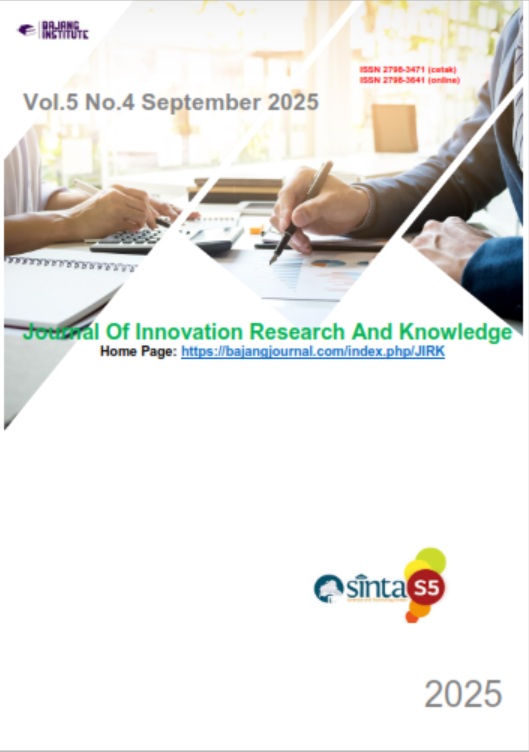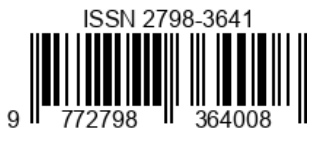PERHITUNGAN VOLUMETRIK PERDARAHAN DENGAN METODE VOLUME AUTOMATIK PADA PEMERIKSAAN CTSCAN KEPALA DI RSU AISYIYAH PONOROGO
DOI:
https://doi.org/10.53625/jirk.v5i4.11198Keywords:
Head CTScan, Segmentation, Bleeding Volume, Automatic MethodAbstract
Background: Head CT Scans for hemorrhage cases at the Radiology Unit of Aisyiyah Ponorogo Hospital use an automated volumetric method to calculate the volume of bleeding. This process involves segmenting the bleeding area, and the volume results are immediately available without manual calculations. Unlike some studies that suggest automated methods require more time, this method was chosen at Aisyiyah Ponorogo Hospital because it utilizes multislice CT Scanning technology, which allows for faster and more accurate estimation of the volume of bleeding. Methods: This study employed a descriptive qualitative approach with observation, interviews, and documentation techniques. The subjects included three radiographers and one radiologist. The study took place at the Radiology Unit of Aisyiyah Ponorogo General Hospital from March to July 2025. Data were collected through direct observation, in-depth interviews, image documentation, and literature review. Data analysis was conducted through transcription, categorization, and narrative presentation based on the research focus. Results: There are differences in the preparation of tools and materials used in bleeding cases. Calculating bleeding volume using automated segmentation-based methods still requires manual involvement and precision in shading the bleeding volume. However, automated methods remain superior because they reduce subjectivity between operators and provide consistent, measurable, accurate, efficient, and reproducible results. Calculating bleeding volume using automated methods is particularly helpful in emergency situations, where clinical decisions must be made quickly. Conclusions: Head CT Scans for hemorrhage cases have not optimized the use of head straps and blankets. The use of blankets and head straps can provide comfort and reduce movement during the examination. Automatic segmentation-based hemorrhage volume calculation improves work efficiency, result consistency, and diagnostic accuracy, while reducing the potential for subjective errors similar to manual methods. This method has nearly perfect agreement with manual methods (coefficient of 0.99), making it worthy of inclusion in medical assistive technology
References
Aditya, D., & Apriantoro, N. H. (2020). CT-Scan Kepala Dengan Klinis Trauma Kapitis Post Kecelakaan Lalu Lintas. KOCENIN Serial Konferens, 1(1), 1–7.
Alahmari, A. (2022). Cold CT Scanner rooms: A simple solution for the patient comfort and for hypothermia cases. Open Journal of Radiology and Medical Imaging, 5, 7-9.
Amin, M. S. (2018). Perbedaan struktur otak dan perilaku belajar antara pria dan wanita; Eksplanasi dalam sudut pandang neuro sains dan filsafat. Jurnal Filsafat Indonesia, 1(1), 38-43.
Andrian, A., & Wahyuni, H. P. (2023). Perdarahan Intrakranial. Jurnal Riset Rumpun Ilmu Kedokteran, 2(1), 150-165.
Astari, F. M., Muhaddist, A. H. Z., Mufida, W., & Fembli, M. (2024). Analysis Of Anatomical Information Using 1 Range: Case Study Of Emergency CT Scan Of The Head With Clinical Mild Head Injury. Jurnal Ilmu Dan Teknologi Kesehatan, 16(1), 16–21.
Bustamin, N. F., Yusuf, N. I., Rahayu, S., & Kaswar, A. B. (2022). Deteksi Area Pendaharahan Otak Pada CT Scan Kepala (Otak) Menggunakan Metode K-Means Clustering. Indonesian Journal of Fundamental Sciences Vol, 8(1).
Hamam, I. M. A., Utami, A. P., KM, S., Dewi, S. N., & Rad, S. T. (2021). TEKNIK PEMERIKSAAN CT-SCAN KEPALA Studi Literatur Stroke Hemorrhagic (Doctoral dissertation, Universitas ‘Aisyiyah Yogyakarta).
Kiswoyo, AS., Wibowo, GM., Ferriastuti, W. 2017. Penghitungan Volumetrik Perdarahan Dengan Metode Volume Automatik (Software Volume Evaluation) dan Metodemanual (Broderick) Pada MSCT Kepala (Study Eksperimen Pada Pasien Perdarahan Intraserebral Di Rs. Haji Surabaya). Ejournal Poltekkes Semarang. Vol. 3, No. 2, ISSN: 2356-301X, Halaman: 231-235.vv
Lampignano, J. P., & Kendrick, L. E. (2018). Bontrager’s Textbook Of Radiographic Positioning And Related Anatomy, Ninth Edition. Missouri : Elsevier, Inc.
Masrochah, S., Lestar, R. Y., & Rusyadi, L. (2021). Metode Pengukuran Volume Perdarahan Pemeriksaan MSCT Kepala pada Kasus Intraserebral Hemmorhage. Jurnal Imejing Diagnostik (JImeD), 7(1), 1-7.
Nardi, C., Taliani, G. G., Castellani, A., De Falco, L., Selvi, V., & Calistri, L. (2017). Repetition of examination due to motion artifacts in horizontal cone beam CT: comparison among three different kinds of head support. Journal of International Society of Preventive and Community Dentistry, 7(4), 208-213.
Prabsattroo, T., Wachirasirikul, K., Tansangworn, P., Punikhom, P., & Sudchai, W. (2023). The dose optimization and evaluation of image quality in the adult brain protocols of multi-slice computed tomography: a phantom study. Journal of Imaging, 9(12), 264.
Rizky, I., Jeniyanthi, N. P. R., & Widiastuti, C. I. A. (2024). Prosedur Pemeriksaan CT Scan Kepala Dengan Klinis Stroke Hemorrhagic Di RS Bhayangkara Makassar. Journal of Educational Innovation and Public Health, 2(1), 101-106.
Roskaraulya, C. K., & Maulina, M. (2024). Studi Kasus Sepsis pada Stroke hemoragik. GALENICAL: Jurnal Kedokteran dan Kesehatan Mahasiswa Malikussaleh, 3(4), 35-44.
Sato, M., Kondo, Y., Takahashi, N., Ohmura, T., & Takahashi, N. (2022). Development of an automatic multiplanar reconstruction processing method for head computed tomography. Journal of X-Ray Science and Technology, 30(4), 777-788.
Salman, I. P. P., Haiga, Y., & Wahyuni, S. (2022). Perbedaan diagnosis stroke iskemik dan stroke hemoragik dengan hasil transcranial doppler di RSUP Dr. M. Djamil Padang. Scientific Journal, 1(5), 393-402.
Sarjani, N. N., Astina, I. K. Y., & Darmawan, I. B. G. (2022). Teknik Pemeriksaan Ct-Scan Kepala Kontras Kasus Cephalgia Di Instalasi Radiologi Rsud Karangasem. Jurnal Kesehatan MIDWINERSLION, 7(September), 26–30.
Scherer, M., Cordes, J., Younsi, A., Sahin, Y. A., Götz, M., Möhlenbruch, M., ... & Orakcioglu, B. (2016). Development and validation of an automatic segmentation algorithm for quantification of intracerebral hemorrhage. Stroke, 47(11), 2776-2782.
Suwartini, T., & Rafindi, M. R. (2024). Perbedaan Hasil Gambaran CT Scan Kepala Untuk Melihat Batasan Tegas Pada Kasus Perdarahan Otak Menggunakan Variasi Filter Di Rs. Jurnal Kesehatan Pertiwi, 6(1), 64-71.
Wijokongko, S., Ardiyanto, J., Fatimah, Utami, A. P., & Rustanto. (2016). Protokol Radiologi CT Scan dan MRI (Jilid 2). Magelang: Inti Medika Pustaka. (2020). Pelatihan penilaian ulang kognitif yang dipandu neurofeedback Rt-fMRI memodulasi respons amigdala pada gangguan stres pascatrauma. NeuroImage: Klinis, 28, 102483.
Xu, J., Zhang, R., Zhou, Z., Wu, C., Gong, Q., Zhang, H., ... & Ma, J. (2021). Deep network for the automatic segmentation and quantification of intracranial hemorrhage on CT. Frontiers in neuroscience, 14, 541817.
Zahuranec, D. B., You, J. J., Morgenstern, L. B., Tsodikov, A., Wing, J. J., Ko, N., … Brown, D. L. (2016). Development and validation of an automatic segmentation algorithm for quantification of intracerebral hemorrhage. Stroke, 47(10), 2609–2612.













